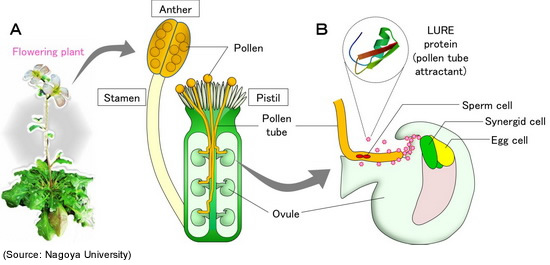
Scientists Unravel Unknown Receptors and Mechanism for Plant Fertilization
March 16, 2016| |
In 2009, Professor Tetsuya Higashiyama of Nagoya University and his colleagues discovered that a synergid cell located next to the egg cell, produces molecules called LUREs that attract pollen tubes in Torenia plants. They also discovered similar LURE peptides in Arabidopsis thaliana in 2012.
Pollen tubes are attracted by LURE peptides, which are produced from ovules, to bring about fertilization. In a recent study, Professor Tetsuya Higashiyama and his fellow biologist Dr. Hidenori Takeuchi revealed for the first time a key kinase receptor PRK6, in the pollen tubes of flowering plants responsible for allowing the pollen tubes to precisely reach the egg cell to enable successful fertilization, without losing its way.
The biologists discovered PRK6 at the tip of the pollen tube in the model plant, A. thaliana. They also found that this receptor works with multiple receptors with a similar structure, to precisely detect the signals transmitted from the pistil. By accepting the various signals sent from the pistil, the kinase receptors enable the pollen tubes to grow to a position inside the pistil where they can detect LURE. Subsequently, the pollen tubes are guided to reach the egg cell and pass on their sperm cells for fertilization.

For more details, read the news release at the Nagoya University website.
| |
Biotech Updates is a weekly newsletter of ISAAA, a not-for-profit organization. It is distributed for free to over 22,000 subscribers worldwide to inform them about the key developments in biosciences, especially in biotechnology. Your support will help us in our mission to feed the world with knowledge. You can help by donating as little as $10.
-
See more articles:
-
News from Around the World
- Suppressing Growth: Opposition to GMOs Hurting Developing Nations
- New Study Identifies Sweet Corn Genes for Crowding Tolerance
- Study Suggests Climate Change Impact on Agriculture is Underestimated
- Researchers Discover Gene That Protects against Toxic Byproducts of Photosynthesis
- Scientists Unravel Unknown Receptors and Mechanism for Plant Fertilization
- New EU Project Focuses on Crops Important for Food Security and Bio-Economy
-
Research Highlights
- Ectopic Expression of PtCYP714A3 from Populus trichocarpa Improves Salt Tolerance in Transgenic Rice
- Kn1 Gene Overexpression Improves Transformation Efficiencies of Citrus Cultivars
- OsBBX14 Delays Heading Date in Rice
-
Beyond Crop Biotech
- Abiotic Stress Tolerance Genes Characterized in Brown Seaweed
- Scientists Develop GM Microbe for Monogastric Animal Nutrition
- Researchers Discover MicroRNA that may Protect from Obesity and Diabetes
-
Announcements
- Genome Editing and Gene Modulation Congress 2016
- 3rd Plant Genomics Congress: Asia
- 5th International Conference and Exhibition on Metabolomics
-
Read the latest: - Biotech Updates (December 17, 2025)
- Gene Editing Supplement (December 17, 2025)
- Gene Drive Supplement (February 22, 2023)
-
Subscribe to BU: - Share
- Tweet
